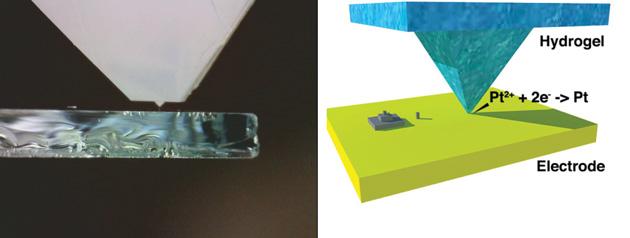We’ve seen the 3Doodler in action for about a year now, and it’s pretty neat. Some people have developed uses for the 3D printing pen outside fun little “3Doodles,” including a recent use in creating an exoskeleton for healing a hand fracture, but for the most part the 3Doodler remains mostly a “just for fun” piece of the 3D printing world. South Korean scientists have now come up with a new type of 3D printing pen that quite frankly blows the 3Doodler out of the water; this pen 3D prints on the nanoscale.
Seongpil Hwang and a team of scientists from Korea University are behind this impressive new device. ![]()
“To the best of our knowledge, our hydrogel pen is the first example of a 3D printing pen,” Hwang said of the device. “However, we were motivated by three techniques: dip-pen lithography developed by Chad Mikin of Northwestern University [US], nanopipettes built by Patrick Unwin at the University of Warwick [UK] and micro-nozzels developed by Jennifer Lewis from Harvard University [US].”
While it isn’t quite the first 3D printing pen, it certainly seems to be the first such printing device to work in nanoscale. The pen has a microscopic hydrogel pyramid at its tip, which is soaked at the very tip in an electrochemical reaction-driving electrolyte. It works by creating a nanoscale contact area between the hydrogel tip and the ultramicroelectrode. A nanopositioning system ensures precision in the pen’s application, regulating a faradaic reaction that enables electroplating.
The resulting 3D structures can be created with dimensions under 100 nm. Hwang and his team tested the pen creating tiny platinum deposits onto a gold electrode.
The pen is described in the full paper by Hwang, et al, as a potentially useful tool in the nanospace for electrochemical reactions:
“Our hydrogel pen is a unique alternative to nanopipettes for localized electrochemical reaction; it is also inexpensive and provides high resolution. A hydrogel pen is a microscopic hydrogel pyramid, the sharp apex of which is confined in the nanometer-scale region, and contains an electrolyte for electrochemical reaction. The contact between the tip of the hydrogel pen and a macroscopic electrode surface produces a nanometer-scale area for electrochemical reaction; we refer to this pen as a ‘hydrogel pen for electrochemical reaction’ (HYPER).”
By using this method for electrodeposition, scientists are able to create thin films in a more inexpensive, eco-friendly, and reliable method — now in 3D. Traditional electrodeposition techniques create fairly one-dimensional nanowires, but by using this pen technique 3D geometry is within reach. Furthermore, the pen is an attractive alternative to the oft-used glass nanopipette, as the hydrogel utilized in the pen is actually somewhat simpler to manufacture than the glass, and has an exact geometry that offers a high level of precision.
Materials scientists from across the world are interested in potential applications for this new development. Among them is the University of Oxford’s Dr. Harish Bhaskaran, who noted that “3D additive nanomanufacturing is the next frontier for rapid prototyping of nanoscale components.” Bhaskaran, who was not involved in the creation of this hydrogel pen, continued:
“There are many challenges at these scales and control of features, the reliability of these pens in the long-term, etc, will all play a role in their adoption in products in the future. However, this is an important first step and quite interesting because the technique is scalable.”
The steady-state currents produced by the hydrogel pen are a result of the pyramid shape of they hydrogel, and are formed in a much smaller scale than previously possible. The participating scientific team came to several conclusions at the end of their study:
“This work represents the first report of a hydrogel pen being utilized to investigate electrochemical processes in the nanometer-scale regime and to produce 3D metallic structures. The HYPER provides significant advantages in terms of simplicity, the size of electrodes, reproducibility and cost compared with previous approaches. The theory related to the HYPER indicates electrochemical behavior similar to that of a typical ultramicroelectrode. We have shown that 3D printing by electrodeposition can be performed using the HYPER. The study of localized electrochemistry by the HYPER might offer new opportunities in electrochemistry, nanoscience, 3D printing and SPM.”
Let us know your thoughts on this latest development in the nanoscale 3D printing world in the 3D Printing Hydrogel Pen forum thread at 3DPB.com.
Subscribe to Our Email Newsletter
Stay up-to-date on all the latest news from the 3D printing industry and receive information and offers from third party vendors.
You May Also Like
Supply Chain Management and the Role of 3D Printing Digital Inventories
As the additive manufacturing (AM) industry grows beyond its humble roots as a rapid prototyping technology, it has been adopted by some of the world’s leading companies to produce not...
3D Printing News Briefs, April 6, 2024: Depowdering, Cybertruck Door Handles, & More
In today’s 3D Printing News Briefs, ioTech’s digital manufacturing CLAD technology is opening up opportunities for microelectronics and additive manufacturing. Hexagon and Raytheon Technologies commercially released the Simufact Additive Process...
$230M Series D Fuels Divergent’s Automated 3D Printing and Assembly Technology
In a significant development for the world of additive manufacturing (AM), Divergent Technologies, known for its comprehensive digital industrial production system, announced the successful completion of a $230 million Series...
Will Formlabs Go Public? 3D Printing Double Unicorn Reinforced by Microsoft CMO as Board Member
Alright, I’ll say what you’re thinking: they’re definitely going to go public. Today, Formlabs announced that Chris Capossela, Microsoft’s Executive Vice President and Chief Marketing Officer, is set to join...

































